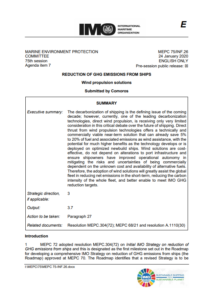Comoros flag has submitted a wind propulsion information paper to IMO’s Marine Environment Protection Committee (MEPC 75), stressing that wind propulsion, as one of the leading decarbonization technologies at the moment, is receiving very limited consideration in the critical debate of the future of shipping.
When deployed on suitable ships, wind reduces overall demand for alternative, costly, zero-emission fuels and can be used in hybrid combination with new zero-emission fuels to reduce overall operational costs for shipowners, the paper reads, adding that there are a number of regulatory and non-regulatory barriers that can be addressed to remove unnecessary restrictions on the uptake of this technology.
Direct thrust from wind propulsion technologies offers a technically and commercially viable near-term solution that can already save 5% to 20% of fuel and associated emissions as wind assistance, with the potential for much higher benefits as the technology develops or is deployed on optimized newbuild ships.
Among the key advantages of wind solutions is that these are cost-effective, do not depend on alterations to port infrastructure and “ensure shipowners have improved operational autonomy in mitigating the risks and uncertainties of being commercially dependent on the unknown cost and availability of alternative fuels“.
As such, the adoption of wind solutions is seen as an enabler for the industry to meet IMO GHG reduction targets.
Specifically, the paper cites an overview of the key advantages of wind propulsion:
- The installation of wind propulsion technologies reduces the overall demand for both fossil fuels and new alternative, zero-emissions fuels (hydrogen, ammonia, power-to-X, biofuels, batteries etc.). These alternative fuels will also be in demand from all other economic sectors and all research suggest that they will have significantly higher cost than fossil fuels, therefore negatively impacting the commercial performance of ships and increasing costs of shipping to the consumer. Wind thus helps mitigate these costs, and the uncertainty and availability risks associated with the adoption of these alternative fuels.
- The cost of the wind is only pegged to the cost of the technology itself and all innovation developments reduce its cost and improve its efficiency, and thus it can be stated with certainty that the costs of maritime wind technology will follow the same cost reduction trajectory once this has crossed the initial “innovation hump”.
- These technology solutions also have the important potential for enabling Small island developing States (SIDS) and least developed countries (LDCs) to provide far more economical and sustainable shipping services both domestically and internationally.
- Publicly available results confirm the projected savings, e.g. 6.1% savings for two small retrofitted rotors on a ro-ro ship in operation since 2014, 8.2% savings for two larger rotors installed on an LR2 product tanker and approximately 20% savings achieved with a relatively large single rotor installed on a small general cargo ship.
There is a need to create an international level playing field in regulation to enable a more “wind friendly” environment so that all propulsion systems and alternative fuels can be effectively assessed and compared and thus generate the proper decarbonization market conditions.
A number of technical, regulatory and policy documents and proposals will be submitted at subsequent MEPC meetings for consideration, and these will deal with proposed adjustments to EEDI, operational indicators and IMO Data Collection System (DCS) among others.
Find out the paper herebelow:































































